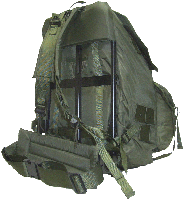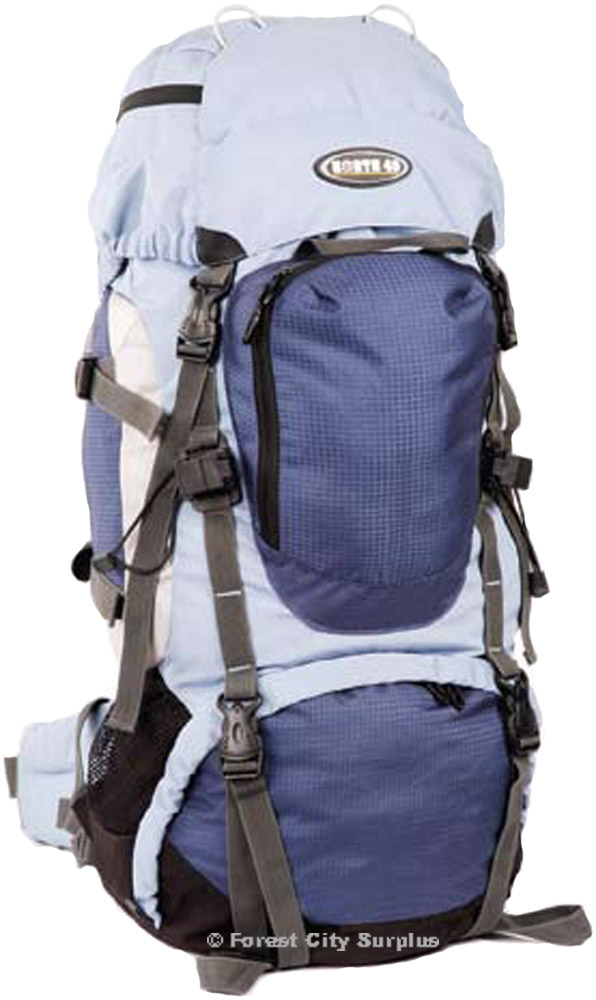A good backpack can make or break your outdoor adventures. Before purchasing one for use on your next expedition, here’s some information a backpacker should consider:
- Primary use

- Pack design
- Weight
- Size
- Frame type
- Construction
- Materials
- Cost
- Fitting your Backpack
- Finding your pack size
- Suspension system
Primary use of your pack: Day trip, overnight hike, long trek
Take a few minutes to think about the main ways you will be using the pack. Also, consider frequency of use. A pack you plan to use infrequently need not be as durable as one you’ll use every day. If you’re going overland on an extended hiking and camping adventure, your choice of pack is more critical than if you’re just toting books around campus. In this article, we’ll focus on high-use packs and discuss some of the features you should look for in lightweight, quality backpacks.
Size does matter: Choose it carefully
Lay out all the outdoor gear and supplies you’re planning to carry in the pack on a flat surface like a large table or a bed. You’ll be surprised at how much there is! Especially if you need to carry your food, shelter and other equipment in the pack. Choose a large pack in this case. A large pack is generally rated at 4000 cubic inches (65 litres) or more. Planning just a short jaunt to the back-country? A daypack of 1000 (16 litres) to 2000 cubic inches (33 litres) might be just right to carry your gear, lunch, water bottle and an energy bar or two. For campground-type camping, a medium-sized pack will work well for your clothes and personal care items. These packs have a capacity of 2000-4000 cubic inches (33-65 litres) and will work well if you transport your tent and food separately in a car or canoe, for example. Regardless of size, the pack should have a waist belt and contoured, padded shoulder straps. The waist belt allows the weight of the pack to be evenly distributed.
Frame design: Two major types
If your adventure will take you away from home for more than a day, you should choose a pack with a frame. Frames are either internal or external. While both types lend support to the pack, there are important differences.
Internal frame packs have the following features:
- Pack support system is internally integrated into the pack design.
- Frame is designed to transfer a substantial portion of the weight to the hips, which are stronger for load bearing than the shoulders.
- Internal frame stays are usually made of aluminum or carbon fiber.
- Internal frame stays should be contoured to match your spine’s curvature.
- Internal frame stays run from the top of the pack down to the hip belt and help to stabilize the pack as well as distribute weight to the hips.
- If you choose a pack with a frame sheet, remember that frame sheets have little effect on weight distribution. Frame sheets are heavy and prevent a concave profile across the back. A concave profile is necessary to give the best weight distribution. However, frame sheets do improve back shaping compared to twin vertical stays which allow the back panel to round out.
- Internal frames are designed to have a low profile that fits the curves of the body. For that reason, they often claim to give the pack better balance. However, balance depends on how close the center of gravity of the load is to the body. Internal frames are often quite deep when viewed from the side so that the load hangs a long way from the back. It’s not an optimal configuration for good pack balance.
External Frame Backpacks or ALICE packs have the following features:
- External frames are often are quite slim from the side and therefore get the load closer to the back. External packs offer better balance unless the load is carried much higher.
- External-framed backpacks are generally older and less complex in design than internal packs
- The support system is outside the pack. The pack attaches to the frame.
- The frame is generally made of tubular aluminum and is stiffer than an internal frame.
- External frames distribute weight and stabilize loads similar to internal frames.
- Frame members are not curved to body contours. This allows an airspace between the pack and the body that’s more comfortable in hot or humid weather.
- Less expensive than internal frame packs. Pack Design: Features to look for
- Customizable harness sizing and shaping to allow a precision fit.
- Ease of removing and shaping frames to match back shape.
- Harness movement systems to allow free body movement, greater agility, stability and balance.
Many backpackers prefer packs that are made of one or more of the following materials:
- Nylon pack cloth
- Ballistic nylon
- Cordura nylon
- Ripstop nylon
- Polyester/cotton
Nylon is the material of choice because of its durability, strength and resistant to abrasion. Choose a pack that is treated to be water-repellent or resistant. If your pack isn’t water repellent, consider purchasing a water-repellent cover for it. Poly/cotton swells when wet. Nylon packs tend to leak along their seams. Look for packs that have waterproof liners with taped seams. Seams can also be heat-welded to make them waterproof. Look for reinforced stitching at stress points, such as where straps are attached. Zippers should be reinforced. Pockets and loops should be bar tacked. Webbing should also be reinforced. In places where the pack is subject to abrasion, such as the bottom, the pack should have an extra layer or two of abrasion-resistant material. The back of the pack should curve like the stays of the internal frame and should use materials that are breathable and that wick perspiration away from the body.
Pack weight: Light or heavy weight
- Choose light weight if you are optimizing all your equipment for low weight.
- Choose heavy weight if you don’t mind carrying heavy loads and heavy gear. Also choose heavy weight if you hike in rough terrain and bush.
Pack cost: You get what you pay for
The conventional wisdom is to buy the best pack you can afford. A flimsy or uncomfortable pack can make your backpacking or hiking trip a disaster. Like shoes or other hiking equipment, backpacks and backpacking equipment are critical pieces of hiking gear. Consider it an investment: this is no place to cheap out. The money spent on a top-end pack for long treks outdoors will repay you with years of comfort and utility. Don’t underestimate its value.
Fitting Your Backpack
Having a proper fit is really the most important factor in selecting a pack. It’s hard to enjoy beautiful vistas if your pack is causing you pain. The size of the pack and the suspension system are the main considerations in fitting a pack. Finding your pack size the length of your back, not your actual height is the most important factor in determining the right pack size. For example a short pack can fit taller people if they have short backs and vice versa. How to find your back length: Your back length is represented by the distance between the most prominent bump or vertebrae in your neck (located in line with the top of your shoulders) and the top of your hipbone. Once you have this measurement you can use it can be used to find your pack size where ever you shop. Suspension System If the suspension system is well designed most of the packs weight should transfer comfortably to your hips and the load shouldn’t cause strain on your back. Try the pack out When first trying the pack on loosen the straps on the harness and become familiar with how they affect the fit of the pack. Now load the pack with 10 to 15 kg (22 to 33 pounds) and put it on. Fasten and tighten the hip belt buckle and make sure the padding wraps right around your hip bones. The shoulder straps should feel snug and not squeeze your neck. The strap ends shouldn’t be anymore than 10 cm (4 inches) from your armpits. Adjust the top stabilizer straps for the most comfortable position which should have them at about a 45-degree angle. Fasten the sternum strap and adjust the lower stabilizing straps until they feel comfortable. Now fine-tune the fit by walking around and playing with the adjustments. If a pack that fits correctly it should feel like and extension of your body. If it doesn’t feel right now it certainly won’t after hours on the trail. Conclusion: Purchasing a backpack Primary use, size, frame type, design, features, construction, materials, weight, cost, fit and comfort are important components in your decision to purchase a backpack. Whether you’re hiking, biking or mountaineering, your pack should enhance your outdoor experience and enjoyment. A carefully-considered decision when buying a backpack can go a long way toward making your outdoor adventures the best that they can be.
Rita Liotta is a successful freelance writer offering guidance and suggestions for consumers regarding camping stoves, pocket knives, compass and topographical maps. Her many articles give information and tips to help people save money and make smarter decisions.
Backpacking TipsDozens of free tips on backpacking. International Backpacking Association Connect with other backpackers. Travel insurance for backpackers. Backpacking information |
Backpacking Travel Guide LinksAnswers to common backpacking questions
Association of Canadian Mountain Guides Internationally recoginzed experts. |


I enjoy spending time outdoors during the summer. My friends and I would take our camping gear, drive up th the foot of the nearest hiking trail, set up our tents and sleep under the stars. It’s an amazing experience.
I got a lot of useful tips about right backpack from this article. Thank you very much!